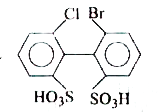Which of the following shows coordination isomerism?
[Co(NH3)5NO2]CI2
[Co(NH3)5][Cr(CN6]
[Pt(NH3)5CI]
K2[Ag(S2O3)2]
To determine which of the given complexes shows coordination isomerism, we need to analyze each option based on the definition of coordination isomerism. Coordination isomerism occurs when there are different arrangements of ligands around a central metal ion, leading to different structural formulas while maintaining the same molecular formula.
1. Understanding Coordination Isomerism:
- Coordination isomerism occurs when both cation and anion in a complex contain coordination complexes. This means that at least one of the ions must be a complex ion.
2. Analyzing Each Option:
- Option 1: C1H3O5 NO2Cl2
- This does not appear to contain any complex ions, so it cannot exhibit coordination isomerism.
- Option 2: Cr(CN)6
- This is a complex ion (Cr with CN ligands). However, we need to check if there is a corresponding anion that is also a complex ion. This option is incomplete as it lacks an anionic counterpart.
- Option 3: (Pt(NH3)5Cl)
- This is a complex cation with one chloride ion. There is no anionic complex present, so it cannot show coordination isomerism.
- Option 4: K2(Ag(H2O)3)
- This contains a complex cation (Ag(H2O)3) and the potassium ions (K+) as counterions. However, it does not have a corresponding anionic complex.
3. Identifying the Correct Option:
- Coordination isomerism typically requires both a cationic and an anionic complex.
- Since none of the options provided meet the criteria for coordination isomerism, we conclude that none of the options show coordination isomerism.
Conclusion:
None of the given complexes exhibit coordination isomerism based on the analysis of their structures and the presence of both cationic and anionic complexes.
- Coordination isomerism occurs when both cation and anion in a complex contain coordination complexes. This means that at least one of the ions must be a complex ion.
- Option 1: C1H3O5 NO2Cl2
- This does not appear to contain any complex ions, so it cannot exhibit coordination isomerism.
- Option 2: Cr(CN)6
- This is a complex ion (Cr with CN ligands). However, we need to check if there is a corresponding anion that is also a complex ion. This option is incomplete as it lacks an anionic counterpart.
- This is a complex cation with one chloride ion. There is no anionic complex present, so it cannot show coordination isomerism.
- This contains a complex cation (Ag(H2O)3) and the potassium ions (K+) as counterions. However, it does not have a corresponding anionic complex.
- Coordination isomerism typically requires both a cationic and an anionic complex.
- Since none of the options provided meet the criteria for coordination isomerism, we conclude that none of the options show coordination isomerism.
None of the given complexes exhibit coordination isomerism based on the analysis of their structures and the presence of both cationic and anionic complexes.
Topper's Solved these Questions
- ALCOHOLS, PHENOLS AND ETHERSBOOK - AAKASH INSTITUTE ENGLISHCHAPTER - ALCOHOLS, PHENOLS AND ETHERSEXERCISE - Try yourself
5 Videos
- ALCOHOLS, PHENOLS AND ETHERSBOOK - AAKASH INSTITUTE ENGLISHCHAPTER - ALCOHOLS, PHENOLS AND ETHERSEXERCISE - Exercise
40 Videos
- ALCOHOLS, PHENOLS AND ETHERS BOOK - AAKASH INSTITUTE ENGLISHCHAPTER - ALCOHOLS, PHENOLS AND ETHERS EXERCISE - Try Yourself
5 Videos
Similar Questions
Knowledge Check
Which of the following will show optical isomerism?
A B
B C
C D
D
Which of the following cannot show linkage isomerism?
ANO−2BSCN−CCN−DNH3
Which of the following can show conformational isomerism:
View SolutionWhich of the folllowing shows geometrical isomerism ?
View SolutionWhich of the following will show optical isomerism? .
View SolutionWhich of the following will show optical isomerism?
View SolutionWhich of the following can show geometrical isomerism.

View SolutionWhich of the following can show geometrical isomerism?
View Solution